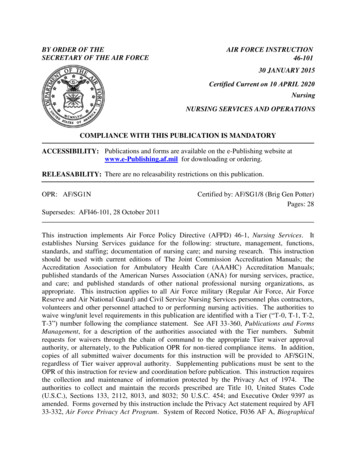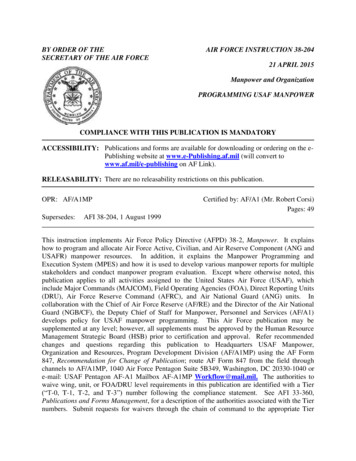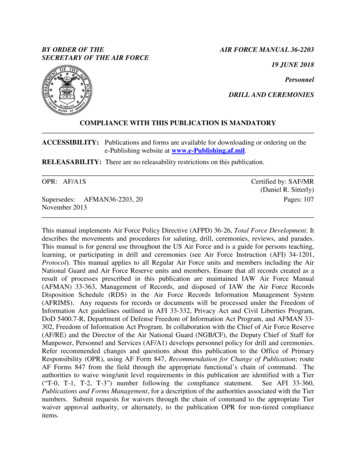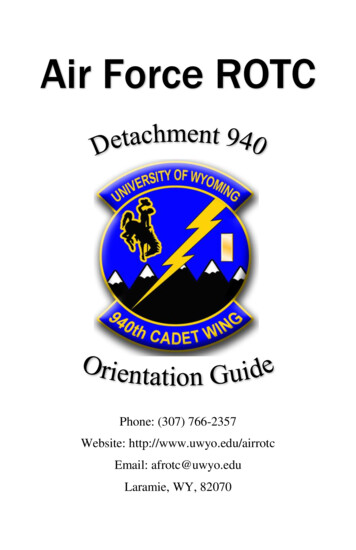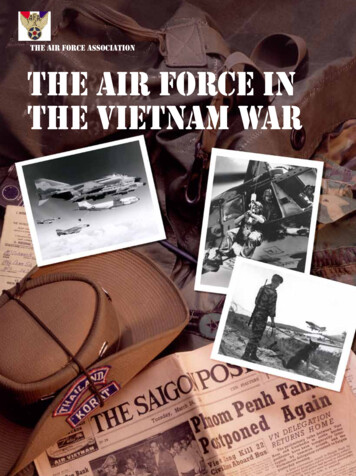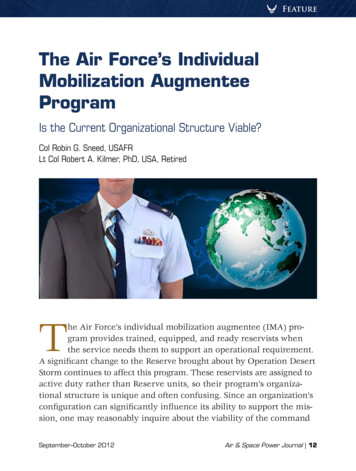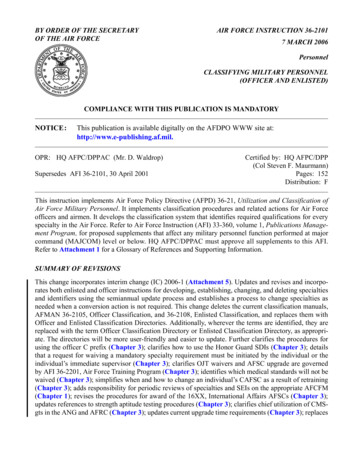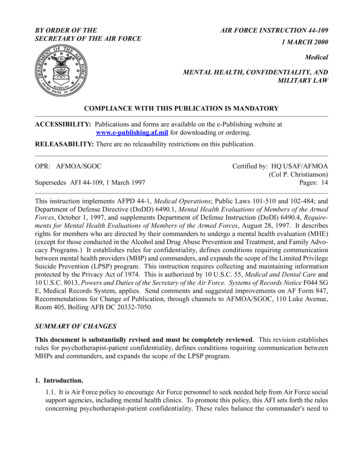
Transcription
DEPARTMENT OF THE AIR FORCEHeadquarters US Air ForceWashington, DC 20330-1000CFETP 5R0X1Parts I and II4 November 2019AFSC 5R0X1Religious AffairsCAREER FIELD EDUCATIONAND TRAINING PLANThe olive wreath surrounding the shield symbolizes the peace that we defend through theexecution of Warrior Care.The pair of receptive hands symbolizes protection from material and spiritual foes. The openedand outstretched hands indicate both the desire to experience the divine and the willingness toserve others in their faith experience.The three levels of award are signified by the addition of a star centered above the shield for thesenior level and a star surrounded by an olive branch for the master level.ACCESSIBILITY: Publications and forms are available on the e-publishing website at www.epublishing.af.mil for downloading or ordering.RELEASABILITY: There are no releasability restrictions on this publication.
SUMMARY OF CHANGESThis publication was changed to include a career field name change from Chaplain Assistant toReligious Affairs. In addition, the STS was substantially revised and must be completelyreviewed.
RELIGIOUS AFFAIRS SPECIALTYAFSC 5R0X1CAREER FIELD EDUCATION AND TRAINING PLANTable of ContentsPART IPreface 1Abbreviations/Terms Explained 2Section A--General InformationPurpose 6Use 6Coordination and Approval of the CFETP 7Section B--Air Force Specialty (AFS) Progression and InformationSpecialty Description 8Skill and Career Progression 9Apprentice Level (3) 9Journeyman Level (5) 10Craftsman Level (7) 10Superintendent Level (9) 10Training Decisions 10Community College of the Air Force 10Career Path 14Section C--Skill Level Training RequirementsPurpose 15Specialty Qualification RequirementsApprentice Level (3) 15Journeyman Level (5) 16Craftsman Level (7) 17Superintendent Level (9) 18Section D--Resource Constraints 19Section E--Transitional Training Guide 19i
PART IISection A--Specialty Training Standard (STS) 20Section B--Course Objective List (COL) 36Section C--On-the-Job Training (OJT) Support Materials 36Section D--Training Course Index 37Section E--MAJCOM Unique Requirements 38OPR: 335 TRS/TRRCertified by: CMSgt Robert Jackson, AFCFM, AF/HCCSupersedes: CFETP 5R0X1, 1 November 2013Pages: 38ii
RELIGIOUS AFFAIRS SPECIALTYAFSC 5R0X1CAREER FIELD EDUCATION AND TRAINING PLANPart IPreface1. This Career Field Education and Training Plan (CFETP) is a comprehensive education andtraining document that identifies life-cycle education and training requirements, training supportresources, and minimum core task requirements for this specialty. The CFETP will providepersonnel a clear career path to success and will instill rigor in all aspects of career field training.NOTE: Civilians occupying associated positions will use Part II to support duty positionqualification training.2. The CFETP consists of two parts; supervisors plan, manage, and control training within thespecialty using both parts of the plan.2.1. Part I provides information necessary for overall management of the specialty. Section Aexplains how everyone will use the plan; Section B identifies career field progressioninformation, duties and responsibilities, training strategies, and career field path; Section Cassociates each level with specialty qualifications (knowledge, education, experience, training,and other); and Section D indicates resource constraints. Some examples are funds, manpower,equipment and facilities. Section E identifies transition training guide requirements for SSgtthrough MSgt.2.2. Part II includes the following: Section A: identifies the Specialty Training Standard (STS)and includes duties, tasks, technical references to support training, Air Education and TrainingCommand (AETC) conducted training, wartime course and core task and correspondence courserequirements. Section B: contains the course objective list (COL) and training standardssupervisors will use to determine if Airmen satisfied training requirements. Section C: identifiesavailable support materials. An example is a Qualification Training Package (QTP), which maybe developed to support proficiency training; Section D: identifies a training course indexsupervisors can use to determine resources available to support training. Included here are bothmandatory and optional courses; Section E: identifies MAJCOM unique training requirementssupervisors can use to determine additional training required for the associated qualificationneeds. At unit level, supervisors and trainers will use Part II to identify, plan and conducttraining commensurate with the overall goals of this plan.3. Using guidance provided in the CFETP will ensure individuals in this specialty receiveeffective and efficient training at the appropriate points in their career. This plan will enable usto train today’s work force for tomorrow’s jobs.1
ABBREVIATIONS/TERMS EXPLAINEDAdvanced Distributed Learning (ADL) An evolving, outcomes-focused approach toeducation, training and performance aiding that blends standards-based distributed learningmodels emphasizing reusable content objects, content and learning management systems,performance support systems/devices, web applications services and connectivity. ADL is anevolution of distributed learning (distance learning) that emphasizes collaboration on standardsbased versions of reusable objects, networks and learning management systems, yet may includesome legacy methods and media. ADL is structured learning that takes place without requiringthe physical presence of an instructor. Although the AF uses the term advanced distributedlearning, some federal agencies and DoD components may use the term distance learning. Theseterms refer to the same basic concept.Advanced Training (AT) Formal course that provides individuals who are qualified in one ormore positions of their Air Force Specialty (AFS) with additional skills and knowledge toenhance their expertise in the career field. Training is for selected career Airman in theadvanced level of the AFS.Air Force Career Field Manager (AFCFM) Representative appointed by the respective HQUSAF Deputy Chief of Staff or Under Secretariat, to ensure assigned AF specialties are trainedand utilized to support AF mission requirements. The AFCFM is the OPR, but will work inconcert with MAJCOM Functional Managers (FMs) as required.Air Force Specialty (AFS) A group of positions with the same title and code that requirecommon qualifications.Air Reserve Component (ARC) – This term is used as an overarching term when referring toboth the Air National Guard and Air Force Reserve component together.Career Field Education and Training Plan (CFETP) The CFETP is a comprehensive coretraining document identifying: life-cycle education and training requirements; training supportresources; and minimum core task requirements for a specialty. The CFETP aims to givepersonnel a clear path and instill a sense of industry in career field training.Religious Affairs Apprentice Course (RAAC) – The Religious Affairs Apprentice Course is aninitial skills technical training course (Type-3) providing training to newly assigned ReligiousAffairs Airmen. Upon graduation, students are awarded the 3-skill level.Core Task Tasks the AFCFM identify as minimum qualification requirements for everyonewithin an AFSC, regardless of duty position. Core tasks may be specified for a particular skilllevel or in general across the AFSC. In this CFETP, core tasks are identified with a 5 or 7 incolumn 2 of the STS.2
Course Objective List (COL) A publication derived from initial and advanced skills coursetraining standard, identifying the tasks and knowledge requirements and respective standardsprovided to achieve a 3- or 7-skill level in this career field. Supervisors use the COL to assist inconducting graduate evaluations.Direct Reporting Unit (DRU) A subdivision of the Air Force, directly subordinate to theChief of Staff. A DRU performs a mission that does not fit into any of the MAJCOMs. A DRUhas many of the same administrative and organizational responsibilities as a MAJCOM.Distributed Training Structured learning mediated with technology that does not require thephysical presence of the instructor. Distributed learning models can be used in combination withother forms of instruction or it can be used to create wholly virtual classrooms.Duty Position Tasks Tasks assigned to an individual for the position currently held. Theseinclude as a minimum all core tasks that correspond to the duty position as directed by theAFCFM or MFM, and tasks assigned by the supervisor.Field Operating Agency (FOA) – FOAs are subdivisions of the Air Force directly subordinateto a headquarters US Air Force functional manager. A FOA performs field activities beyond thescope of the MAJCOMs. The activities are specialized or associated with an Air Force-widemission and do not include functions performed in management headquarters (such as AMC),unless specifically directed by a DoD authority. Two examples are the Air Force PersonnelCenter (AFPC) under the DCS, Personnel, and the Air Force Office of Special Investigations(AFOSI) under The Inspector General. Similar organizations at MAJCOM level are calledMAJCOM FOAs.Functional Manager – Senior leaders, designated by the appropriate functional authority (FA)who provide day-to-day management responsibility over specific functional communities at theMAJCOM, FOA, DRU or ARC level. While they should maintain an institutional focus inregards to resource development and distribution, FMs are responsible for ensuring theirspecialties are equipped, developed and sustained to meet the functional community’s mission aswell as encourage force development opportunities in order to meet future needs of the total AirForce mission.Go/No-Go The “Go” is the stage at which a trainee individual has gained enough skill,knowledge and experience to perform the tasks without supervision, meeting the task standard.“No-Go” is the stage at which the trainee has not gained enough skill, knowledge, andexperience to perform the task without supervision, does not meet task standard.Initial Skills Training A formal school course that results in an AFSC 3-skill level award forenlisted or mandatory training for upgrade to qualified officers.Master Task List (MTL) – A comprehensive list (100%) of all tasks performed within a workcenter and consisting of the current CFETP or Air Force Job Qualification Standard (AFJQS)and locally developed AF Forms 797 (as a minimum). Should include tasks required fordeployment and/or UTC requirements.3
Master Training Plan (MTP) – Employs a strategy for ensuring the completion of all workcenter job requirements by using a Master Task Listing and provides milestones for task, CareerDevelopment Course (CDC) completion and prioritizes deployment/UTC, home station trainingtasks, upgrade and qualification tasks.Occupational Survey Report (OSR) A detailed report showing the results of an occupationalsurvey of tasks performed within a particular AFS.On-The-Job Training (OJT) Hands-on, “over-the-shoulder” training conducted to certifypersonnel in both upgrade (skill level award) and job qualification (position certificationtraining).Proficiency Training Additional training, either in-residence or exportable advanced trainingcourses, or on-the-job training, provided to personnel to increase their skills and knowledgebeyond the minimum required for upgrade.Qualification Training (QT) Hands-on performance training designed to qualify personnel ina specific position. This training occurs both during and after upgrade training to maintain up-todate qualifications.Resource Constraints Resource deficiencies, such as money, facilities, time, manpower andequipment that preclude desired training from being delivered.Specialty Training The total training process used to qualify Airmen in their assignedspecialty.Specialty Training Standard (STS) An AF publication that describes an AFS in terms oftasks and knowledge an Airman in that specialty may be expected to perform or to know on thejob. Also identifies the training provided to achieve a 3-, 5- or 7-skill level within an enlistedAFS. It further serves as a contract between AETC and the functional user to show which of theoverall training requirements for an AFSC are taught in formal schools and correspondencecourses.Standard An exact value, a physical entity, or an abstract concept, the appropriate authority,custom, or common consent sets up and defines to serve as a reference, model, or rule inmeasuring quantities or qualities, developing practices or procedures, or evaluating results. Afixed quantity or quality.Total Force All collective Air Force components (active, reserve, guard, and civilianelements) of the US Air Force.Trainer – A trained and qualified person who teaches personnel to perform specific tasksthrough OJT methods. Also, equipment used to teach personnel specific tasks.4
Training Capability The ability of a unit or base to provide training. Authorities consider theavailability of equipment, qualified trainers, study reference materials, and so on in determininga unit’s training capability.Type 3 Training – This is the more common AFS-centered training of a continuing natureconducted at an AETC base, location, or station. It includes courses designed for initial training,retraining from one AFS to another, training on special or new equipment and procedures,advancement within an AFS, and initial skill multiphase AFSC awarding courses.Type 5 Training – This training includes training conducted by the Army, Navy, Air Forceagency or unit other than AETC, and other government agencies inside or outside of theDepartment of Defense (DoD).Type 6 Training – Formal courses developed for export to a field location (in place of residenttraining) for trainees to complete without the on-site support of the formal school instructor.Upgrade Training (UGT) Mandatory training leading to attainment (award) of higher level ofproficiency (skill level).Utilization and Training Workshop (U&TW) A forum used to determine education andtraining requirements, by bringing together the expertise to establish the most effective mix offormal and on-the-job training for the AFS skill level. The U&TW process begins with aSpecialty Training Requirements Team (STRT) meeting that is conducted prior to the U&TWand results in the development of a Course Resource Estimate (CRE). The primary participantsin the U&TW process include AFCFM, Training Pipeline Manager (TPM), AETC TrainingManager (TM), MAJCOM Functional Managers (MFMs), ARC personnel, and AFS SubjectMatter Experts (SMEs). Other participants may include representatives from Air Force CareerDevelopment Academy (AFCDA) for CDCs, AETC CDC Writers, and AETC/A3/OAS foroccupational analysis information and briefings, Air Force Personnel Center (AFPC) Education,Training, and Classification, and AETC Instructional Technology Unit (ITU) Representative.5
Section A - General Information1. Purpose: This CFETP provides information necessary for the Air Force Career FieldManager (AFCFM), MAJCOM Functional Managers (MFM), commanders, training managers,supervisors and trainers to plan, develop, manage and conduct an effective and efficient careerfield-training program. This plan outlines the training that individuals in this AFS should receivein order to develop and progress throughout their career. This plan identifies initial skills,upgrade, qualification, advanced and proficiency training. Initial skills training is the AFSspecific training an individual receives upon entry into the AF or upon retraining into thisspecialty for award of the 3-skill level. Normally, this training is conducted by AETC at one ofthe technical training centers. For AFSC 5R0X1, initial skills training is conducted at 335thTraining Squadron, Keesler AFB MS. Upgrade training identifies the mandatory courses, taskqualification requirements, and correspondence course completion requirements for award of the3-, 5-, 7- and 9-skill levels. Qualification training is actual hands-on task performance trainingdesigned to qualify an Airman in a specific duty position. This training program occurs bothduring and after the upgrade training process. It is designed to provide the performance skillsand knowledge required to do the job. Advanced training is formal specialty training used forselected Airmen. Proficiency training is additional training, either in-residence or exportableadvanced training courses, or on-the-job training provided to personnel to increase their skillsand knowledge beyond the minimum required for upgrade. The CFETP has several purposes, toinclude:1.1. Serves as a management tool to plan, manage, conduct and evaluate a career field-trainingprogram. Also, it is used to help supervisors identify training at the appropriate point in anindividual’s career.1.2. Identifies task and knowledge requirements for each skill level in the specialty andrecommends education and training throughout each phase of an individual’s career.1.3. Lists training courses available in the specialty, identifies sources of training, and thetraining delivery method.1.4. Identifies major resource constraints which impacts full implementation of the desiredcareer field training process.2. Uses. The plan will be used by MFMs and supervisors at all levels to ensure comprehensiveand cohesive training programs are available for each individual in the specialty.2.1. AETC training personnel will develop or revise formal resident, non-resident, field andexportable training based upon requirements established by the users and documented in Part IIof the CFETP. They will also work with the AFCFM to develop acquisition strategies forobtaining resources needed to provide the identified training.2.2. MFMs will ensure their training programs complement the CFETP mandatory initial,upgrade, and proficiency requirements. OJT, resident training and contract training or6
exportable courses can satisfy identified requirements. MAJCOM-developed training to supportthis AFSC must be identified for inclusion into this plan.2.3. Each individual will complete the mandatory training requirements specified in this plan.The lists of courses in Part II will be used as a reference to support training.3. Coordination and Approval. The AFCFM is approval authority and will initiate an annualreview of this document (through 335 TRS/TRR) to ensure currency and accuracy. MAJCOMrepresentatives and AETC training personnel will identify and coordinate on the career fieldtraining requirements. Using the list of courses in Part II, they will eliminate duplicate training.7
Section B - AFS Career Progression and Information4. Specialty Description.4.1. Specialty Summary. The Religious Affairs Career Field builds a culture of spiritual careand facilitates the free exercise of religion of Air Force members, their families and otherauthorized personnel. As experts in principles of religious diversity, religious accommodation,major faith group requisites, privileged communication and religious program management,Religious Affairs Airmen advise leaders at all levels on religious accommodation, ethical, moraland morale issues, especially for the enlisted force. As the enlisted component of ReligiousSupport Teams (RST), Religious Affairs Airmen are uniquely trained in crisis intervention toinclude intervention counseling in moments of crisis, response to crises and suicide preventionand intervention. In addition, Religious Affairs Airmen are actively engaged and intentionallyintegrated into unit engagement plans to include unit meetings, commander calls, training withthe unit and other unit activities. They also are trained in religious support to hospitals andmortuaries. Religious Affairs Airmen meet the diverse needs of military communities bymanaging religious programs, administrative, financial, and facility support. They recruit, trainand organize volunteers for specific religious ministries. Religious Affairs Airmen conductthemselves in a manner that brings credit, pride and honorable distinction to the United StatesAir Force and its Chaplain Corps. Related DoD Occupational Subgroup: 156100.4.2. Duties and Responsibilities.4.2.1. Manage religious programs. Religious Affairs Airmen partner with chaplains to develop,manage, control and evaluate religious programs to ensure effectiveness. This capability iscritical to Airmen and their dependents in contingency and steady state environments.4.2.1.1. Resource and manage support of religious observances to include worship, liturgies,rites and other religious requirements for all faith groups.4.2.1.2. Manage, in conjunction with Chaplain Corps personnel (e.g., Chaplains, GS [GeneralService] employees) manpower positions, personnel, lay volunteers, appropriated funds, ChapelTithes and Offerings Funds (CTOF), non-appropriated and Morale, Welfare and Recreation(MWR) funds, religious facilities, supplies and equipment.4.2.1.3. Manage chapel administration to include records management, forms, publications,publicity, professional correspondence, background checks, operating instructions, suspenseactions and other administrative needs of the Chaplain Corps mission.4.2.2. Advise leadership at all levels on religious accommodation, ethical, moral, morale issuesand needs, primarily for, and regarding, the enlisted force. Commanders, command chiefs,group superintendents, first sergeants and supervisors at all levels should know the issuesaffecting their Airmen and how to best address them. Religious Affairs are a trusted source forvalid, real-time information. As the faces and voices of our enlisted Airmen, Religious Affairsintegrate into units and appropriately advise leaders on the issues and challenges Airmen face.8
4.2.3. Conduct crisis intervention counseling. The Chaplain Corps is the only function with100% privileged communication (see 10 U.S.C. Chapter 47A, Military Rules of Evidence, Rule503) and Religious Affairs Airmen are commonly the first line of care for Airmen in need.Facilitating care for Airmen early in a crisis enhances resiliency, mission readiness andcapability. Crisis intervention counseling is an immediate, interventional approach to providingmental and moral support with the aim of restoring the person to the level of functioning prior tothe crisis. This capability includes counseling in moments of crisis, response to crises andsuicide prevention and intervention. Religious Affairs Airmen possess the core capability to carefor Airmen at a point of crisis. They are specially trained to identify potential problems andassist individuals get the professional help they need. Through crisis intervention counseling,Religious Affairs Airmen mitigate crises such as suicide, grief, traumatic stress and other formsof crisis. Religious Affairs Airmen will not, at any time, conduct spiritual counseling and willimmediately refer people in need of spiritual counseling to a Chaplain. Religious Affairs Airmenmay make referrals to other agencies for issues not of a spiritual nature as appropriate.4.2.4. Intentionally integrate, as part of the RST, into unit ministry and engagement plans as aresource for meeting the spiritual needs of Airmen. Unit Engagement is best defined when unitmembers embrace Religious Affairs Airmen as “one of them” through participation in unitmeetings, commander calls and other unit activities. Religious Affairs Airmen conduct unitengagement jointly with their RST partner(s) or independently.4.2.5. Manage RST functions, personnel readiness and deployment taskings. Develop,coordinate and review operations plans and annexes. Coordinate religious and pastoral supportrequirements with base supporting agencies. Manage religious support during contingencies forcombat or humanitarian relief operations. Coordinate religious and pastoral supportrequirements with base agencies. Prepare and present religious customs and culture briefings.Respond to aircraft crash and mass casualty sites, hostage situations, casualty collection points,evacuation and deployment processing points and work centers. Conduct spiritual triage byapplying listening, observation and interviewing skills. Protect privileged communicationobtained through chaplain pastoral counseling and intervention counseling. Coordinate andfacilitate force protection.5. Skill and Career Progression.Adequate training and timely progression from the apprentice to the superintendent skill levelplays an important role in the Air Force's ability to accomplish its mission. It is essential thateveryone involved in training must do his or her part to plan, manage, and conduct an effectivetraining program. The guidance provided in this part of the CFETP will ensure each individualreceives viable training at appropriate points in their career.5.1. Apprentice (3) Level. The Religious Affairs Apprentice course, must be completed for theaward of the 5R031 AFSC. Initial skills training requirements were identified during the 5R0X1STRT meeting held in April 2018. The decision to train specific tasks and knowledge items inthe initial skills course was based on a review of the Occupational Survey Report (OSR) data andsubject matter expert (SME) inputs. Task and knowledge training requirements are identified inthe specialty training standard, at Part II, Sections A and B. Individuals must complete the initialskills course to be awarded AFSC 5R031.9
5.2. Journeyman (5) Level. Qualification in and possession of AFSC 5R031 is mandatory foraward of AFSC 5R051. Upgrade training to the 5-skill level in this specialty consists of task andknowledge training provided in CDC 5R051; completion of the core task requirements identifiedin the STS (Part II, Section A of this CFETP); and all duty position tasks identified by thesupervisor. Mandatory experience consists of religious program management, advisingleadership, crisis intervention counseling and unit engagement.5.3. Craftsman (7) Level. Qualification in and possession of AFSC 5R051 is mandatory foraward of AFSC 5R071. In addition, completion of Religious Affairs Craftsman Course (onceimplemented) is required, begin upgrade training to the 7-skill level upon selection to SSgt.UGT consists of completing all core task requirements identified in the STS (Part II, Section Aof this CFETP) and all duty position requirements identified by the supervisor. Mandatoryexperience consists of managing personnel and resources to advise leadership, conducting crisisintervention counseling, engaging in units and managing religious programs.5.4. Superintendent (9) Level. Qualification in and possession of AFSC 5R071 is mandatoryfor award of AFSC 5R091. SMSgts are awarded AFSC 5R091 upon assuming the requiredgrade, completion of USAF Senior NCO Academy, and recommendation of the supervisor.Mandatory experience consists of leading and managing Chaplain Corps activities.6. Training DecisionsThe CFETP uses a building block approach (simple to complex) to encompass the entirespectrum of training requirements for the Religious Affairs career field. The spectrum includes astrategy for when, where, and how to meet the training requirements. The strategy must beapparent and affordable to reduce duplication of training and eliminate a disjointed approach totraining. Training decisions were made during the 5R0X1 STRT meeting held in April 2018.6.1. Initial Skills. The initial skills course is developed by 335 TRS/TRR at Keesler AFB toprovide training needed to prepare graduates for Religious Affairs apprentice related positions.6.2. Five Level Upgrade Requirements. The 5-level CDC 5R051 is currently developed byEaker Center/AOOT to provide required training for upgrade in Religious Affairs-relatedpositions. The 335 TRS will begin developing the 5-level CDC 5R051 in FY21.6.3. Seven Level Upgrade Requirements. Once developed and implemented, the craftsmancourse is required for 7- level upgrade.7. Community College of the Air Force (CCAF). CCAF is one of several federally chartereddegree-granting institutions; however, it is the only 2-year institution exclusively serving militaryenlisted personnel. The college is regionally accredited through Air University by theCommission on Colleges of the Southern Association of Colleges and Schools (SACS) to awardAAS degrees designed for specific Air Force occupational specialties and is the largest multicampus community college in the world. Upon completion of basic military training andassignment to an AF career field, all enlisted personnel are registered in a CCAF degree programand are afforded the op
DEPARTMENT OF THE AIR FORCE CFETP 5R0X1 . Headquarters US Air Force Parts I and II . Washington, DC 20330-1000 4 November 2019 . AFSC 5R0X1 Religious Affairs CAREER FIELD EDUCATION AND TRAINING PLAN . The olive wreath surrounding the shield symbolizes the peace that we defend through the execution of Warrior Care.


